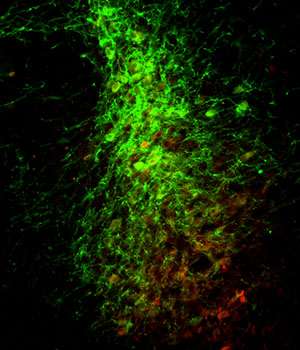Exploring the brain's role in stress-induced anxiety

Calming a neural circuit in the brain can alleviate stress in mice, according to new research that could lay the foundation for understanding stress and anxiety in people.
Using cutting-edge techniques, the researchers at Washington University School of Medicine in St. Louis also showed they could shine a light into the brain to activate the stress response in mice that had not been exposed to stressful situations.
The study is published online July 23 in the journal Neuron.
"We now have a much better idea of the neural circuit involved in producing anxiety following stress," said first author Jordan G. McCall, PhD, a former graduate student in the laboratory of principal investigator Michael R. Bruchas, PhD, associate professor of anesthesiology and neurobiology. "You can imagine that this same response also may be important to longer-term stress-related problems such as post-traumatic stress disorder (PTSD) or anxiety disorder."
The work may lead to the development of new treatments for such disorders, as well as for depression and alcohol and drug abuse.
Neuroscientists already knew that a small structure in the brain called the locus coeruleus (LC) plays a key role in stress and anxiety. Neurons in that region secrete the hormone norepinephrine, which surges when a person is under stress. But using techniques called optogenetics and chemogenetics, the researchers showed they could selectively control the firing of LC neurons, lower norepinephrine levels and prevent the anxiety that normally follows stressful events.
In these techniques, researchers genetically engineer mice with brain cells that have special receptors. Those receptors can be activated by light (optogenetics) or synthetic chemicals (chemogenetics). Those light or chemical signals either trigger or block neuronal activity, giving researchers a way to control the brain circuits in an animal and, thus, the behavior.
As part of the research, the scientists observed mice moving through mazes and roaming freely in an open box.
"Mice usually move toward the wall and try to stay out of the open area, just like a mouse in your house," Bruchas explained. "Anxious mice rarely venture into the center of the box, whereas mice that feel less anxious roam into the middle more often."
Mice that experienced stressful events were more likely to stay near the edges of the box. But when mice were treated with stress-lowering drugs—either beta blockers or alpha 1 blockers, which are used to treat high blood pressure and stress in people—the animals were more likely to venture into the middle of the box, even if they had experienced stressful events.
The researchers also found that activating LC neurons with light made mice in the mazes behave as if they were stressed, even when they had not been exposed to a stressful event.
"With this study, we now understand how a bunch of puzzle pieces fit together in a network that we've demonstrated is critical to stress-induced anxiety," Bruchas said.
More information: "CRH engagement of the locus coeruleus noradrenergic system mediates stress-induced anxiety." Neuron, published online July 23, 2015
















